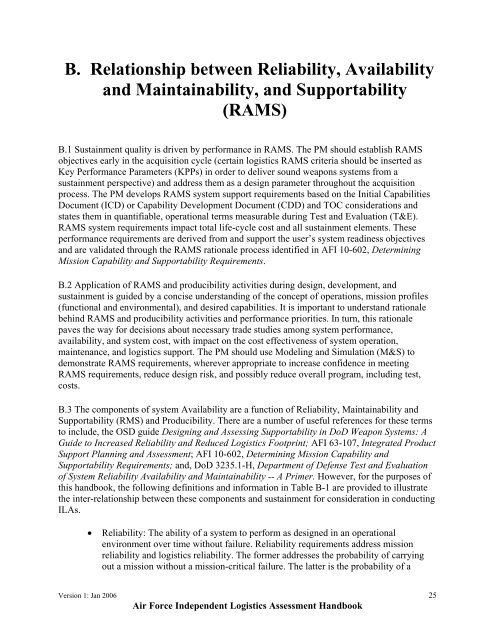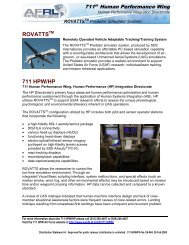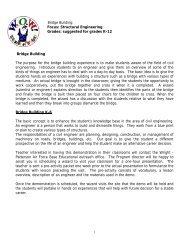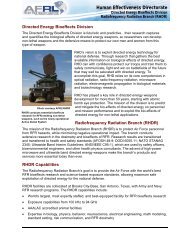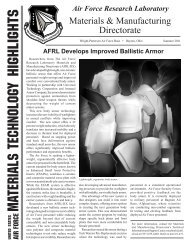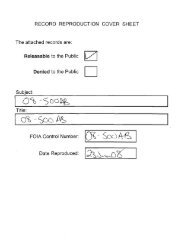USAF ILA Handbook - ACC Practice Center - Defense Acquisition ...
USAF ILA Handbook - ACC Practice Center - Defense Acquisition ...
USAF ILA Handbook - ACC Practice Center - Defense Acquisition ...
You also want an ePaper? Increase the reach of your titles
YUMPU automatically turns print PDFs into web optimized ePapers that Google loves.
B. Relationship between Reliability, Availability<br />
and Maintainability, and Supportability<br />
(RAMS)<br />
B.1 Sustainment quality is driven by performance in RAMS. The PM should establish RAMS<br />
objectives early in the acquisition cycle (certain logistics RAMS criteria should be inserted as<br />
Key Performance Parameters (KPPs) in order to deliver sound weapons systems from a<br />
sustainment perspective) and address them as a design parameter throughout the acquisition<br />
process. The PM develops RAMS system support requirements based on the Initial Capabilities<br />
Document (ICD) or Capability Development Document (CDD) and TOC considerations and<br />
states them in quantifiable, operational terms measurable during Test and Evaluation (T&E).<br />
RAMS system requirements impact total life-cycle cost and all sustainment elements. These<br />
performance requirements are derived from and support the user’s system readiness objectives<br />
and are validated through the RAMS rationale process identified in AFI 10-602, Determining<br />
Mission Capability and Supportability Requirements.<br />
B.2 Application of RAMS and producibility activities during design, development, and<br />
sustainment is guided by a concise understanding of the concept of operations, mission profiles<br />
(functional and environmental), and desired capabilities. It is important to understand rationale<br />
behind RAMS and producibility activities and performance priorities. In turn, this rationale<br />
paves the way for decisions about necessary trade studies among system performance,<br />
availability, and system cost, with impact on the cost effectiveness of system operation,<br />
maintenance, and logistics support. The PM should use Modeling and Simulation (M&S) to<br />
demonstrate RAMS requirements, wherever appropriate to increase confidence in meeting<br />
RAMS requirements, reduce design risk, and possibly reduce overall program, including test,<br />
costs.<br />
B.3 The components of system Availability are a function of Reliability, Maintainability and<br />
Supportability (RMS) and Producibility. There are a number of useful references for these terms<br />
to include, the OSD guide Designing and Assessing Supportability in DoD Weapon Systems: A<br />
Guide to Increased Reliability and Reduced Logistics Footprint; AFI 63-107, Integrated Product<br />
Support Planning and Assessment; AFI 10-602, Determining Mission Capability and<br />
Supportability Requirements; and, DoD 3235.1-H, Department of <strong>Defense</strong> Test and Evaluation<br />
of System Reliability Availability and Maintainability -- A Primer. However, for the purposes of<br />
this handbook, the following definitions and information in Table B-1 are provided to illustrate<br />
the inter-relationship between these components and sustainment for consideration in conducting<br />
<strong>ILA</strong>s.<br />
• Reliability: The ability of a system to perform as designed in an operational<br />
environment over time without failure. Reliability requirements address mission<br />
reliability and logistics reliability. The former addresses the probability of carrying<br />
out a mission without a mission-critical failure. The latter is the probability of a<br />
Version 1: Jan 2006 25<br />
Air Force Independent Logistics Assessment <strong>Handbook</strong>


